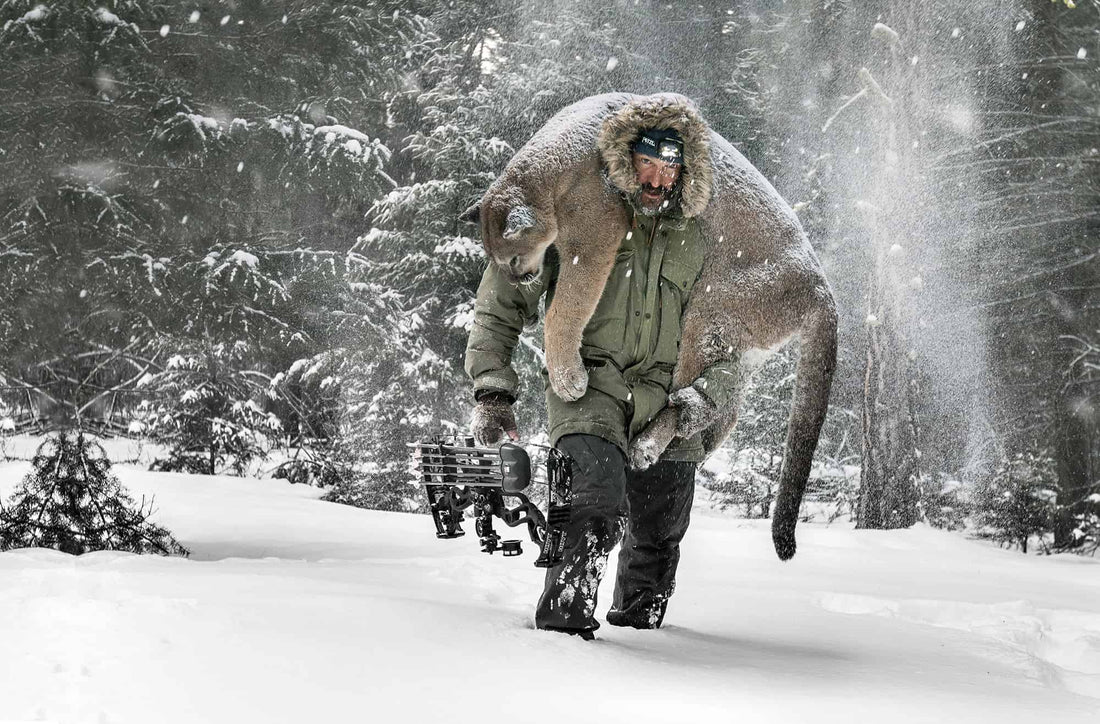
Inside the Mind of Donnie Vincent: Hunting Alaska, Mountain Lions and Storytelling
Share
Adventure, Ethics & Action Steps for the Modern Hunter
By Ryan Uffens, Host of The Hunt Stealth Podcast
When you talk about hunters who’ve redefined the art of storytelling in the wild, Donnie Vincent is in a league of his own. Biologist, explorer, conservationist, filmmaker Donnie wears many hats, but the thread that ties it all together is simple: an unwavering reverence for the wild.
We were lucky enough to sit down with Donnie on The Hunt Stealth Podcast and explore everything from his near-death expeditions to the importance of good gear and ethical hunting. Whether you’re a seasoned backcountry hunter or you’re strapping on boots for your first archery tag, there’s gold in this conversation.
Let’s dig in with key takeaways and action steps you can take into the field right now.
1. Every Hunt is a Story Make Yours Worth Telling
My first elk encounter didn’t end with a full freezer—but it lit a fire in me. Donnie’s films, like Winds of Adak and The Rivers Divide, don’t just show success—they show struggle, uncertainty, and awe. And that’s what makes them real.
Donnie’s take: Great hunts aren’t just about harvesting an animal. They're about the entire experience the planning, the suffering, the solitude, the reset you get when you lose cell service and gain perspective. “I want the oil painting,” Donnie said. “Not just the head on the wall.”
Action Step: Start a hunting journal. Write down what you saw, how you felt, and what the land taught you even when you don’t tag out. That’s your story.
2. Respect the Animal... Always
Donnie’s influence was already guiding me when I passed on a shot at a bull elk standing just 30 yards away because I didn’t have a clean shot on the vitals. That restraint, that respect, is what separates a true hunter from just a shooter.
Donnie’s take: “I want to hunt like someone’s watching me at all times.” He’s serious about ethical shots, knowing your limitations, and giving every animal its due.
Action Step: Practice shooting year-round. Don’t just prepare for the 60-yard shot get dialed at 30. And never take a shot you’re not confident in. Respect is doing it right, even when no one’s around.
3. Preparation is Survival
Donnie’s hunted everything from grizzlies in Alaska to mountain lions in BC. He’s nearly been swept away by ocean storms, frozen on cliff faces, and even tracked big cats through thigh-deep snow. One common thread? Preparation.
Donnie’s take: Don’t guess on regulations. Know your weather patterns. Understand your terrain and your gear. “What looks like a dry creek bed can become a death trap in a flash flood.”
Action Step: Build your “system of systems.” Break your setup into categories:
- Shelter (tent, bag, pad)
- Food & water (filter or purifier?)
- Navigation (map, compass, GPS app)
- First aid & SOS (do you have a Garmin InReach?)
- Clothing (layers that match your terrain & season)
Pro tip from Donnie: Look at trusted hunters’ gear lists and adapt based on your own budget and needs.
4. Know Your Limits and the Landscape
One of Donnie’s most harrowing stories involved cliffside stalking for Dall sheep in Alaska. One slip, and it would’ve been over.
Donnie’s take: “Be honest with yourself. If you have a crippling fear of bears, maybe don’t start in grizzly country.” Know the habitat and the predators. Understand if you’re mentally and physically ready and if you’re not, train.
Action Step: Train like your hunt depends on it because it does. Don’t just do curls in the gym. Load your pack. Hike hills. Get altitude. And if bears or mountain lions are in the area, know the signs and carry the right protection.
5. The Power of Experience: Donnie’s Mountain Lion Hunt
Donnie wasn’t always a believer in lion hunting. But when a biologist and outfitter in BC explained the impact one tom had on California bighorn populations, Donnie agreed to see it for himself. What followed was a 20-kilometer foot pursuit, a snowy showdown, and an experience that changed his perspective forever.
They ate the cat. All of it. And Donnie said the meat was so good it beat out bighorn sheep at the table.
Donnie’s take: “I never wanted to hunt lions. Now I want to go again.”
Action Step: Be open. You don’t have to agree with every hunt or every method but don’t dismiss it until you understand the conservation science behind it. Seek firsthand knowledge before forming opinions.
6. Storytelling as Legacy
Donnie’s storytelling is cinematic, emotional, and visceral for a reason. He learned early to “show, not tell.” His professor taught him that readers or viewers should feel the story, not just hear it.
Donnie’s take: Whether he’s filming in the Arctic or writing voiceovers, he’s not trying to convert people he’s trying to bring them closer to the land, the animal, and the journey.
Action Step: Document your hunts. Capture photos, write blog posts, share short videos. Not to boast, but to build legacy. The next generation won’t just remember your success they’ll remember how you made them feel about the wild.
Final Thoughts: What It Means to Hunt
As a new hunter, I’m still learning every day. But guys like Donnie are showing me—and all of us that hunting isn’t just about killing. It’s about conserving. It’s about feeling small in the best possible way. It’s about earning every step and embracing the struggle.
And more than anything, it’s about never surrendering even when the bull steps three yards from the opening and vanishes into the oak.
If this podcast episode gave you something motivation, knowledge, or just a good story share it with someone who needs to hear it. And if you’re looking for inspiration, go watch Winds of Adak. Then lace up your boots. There’s wild out there waiting.
